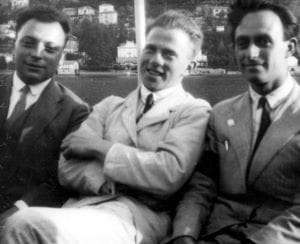A Century of Quantum Mechanics
Come on, Come on, Come on
Yeah, Yeah, Yeah
And they slag off Noel as lyrically incompetent. Say what you will about the Mancunian brothers Gallagher, they are both funny fucks for one, but in 1994 they were as good a rock and roll outfit as ever took a stage – for whatever that's worth? Millions for them anyway.
Life in the 21st century is reader supported, please subscribe to make life sustainable.
CERN has a note that today in 1925, Werner Heisenberg sent Wolfgang Pauli a letter on his efforts with quantum mechanics. He wrote, “All of my pitiful efforts are directed at completely killing off the concept of orbits – which, after all, cannot be observed—and replacing it with something more suitable."
Not only did his pitiful efforts kill the concept of orbiting electrons, they transformed human thought, leading to the creation of nuclear weapons and the transistor, technologies humanity has yet to come to any terms with.
Long ago, I read many of these pre-war quantum physicists (one of history's great democratic communities it should be noted) trying to figure out what they had wrought and what it all meant. They are far and away best at describing their concepts, which have been continually and innumerably misinterpreted since. A few years ago, I ran across a speech Oppenheimer gave in 1955 called Analogy and Science. Here he gives a great description of the radical insights of quantum mechanics:
"The greatest experience in this century for the physicists, even greater than relativity, is the discovery of atomic mechanics.... When one gets to the atomic domain, this is a domain of small actions of limited distances and limited impulses, of things such as you encounter in atoms and nuclei. Then the coarseness of the whole physical universe, its granular or atomic structure, for the first time begins to manifest itself. Not the granulation of the fundamental particles, but the granulation of atomic physics itself, of the quantum of action."
The quantum of action, key to quantum mechanics, is an insight first hit on by Max Plank a few decades before. At its foundation, a notion of discontinuity completely foreign to every day experience, that energy at the atomic level comes only in discrete, noncontinuous bundles.
Oppenheimer continues,
"What this means is that when you're trying to study such a system, there are aspects of it which are accessible to experiment, but are not compatibly or simultaneously accessible to experiment. The famous example is the uncertainty relation. You can study the location of something in time in space, but if you do that, you use an experimental setup which makes it impossible to know exactly what the impulse, or velocity, or energy of the system is. Now you can do the opposite, you can study the impulse, but then you lose account of where it is. You can of course compromise, but you cannot combine."
"One calls these the complimentary aspects, complimentary character of the fundamental observations. That means that you can't talk about an an atom as you can about a classical mechanical system. You can't say the objects in it are here and they're moving in certain orbits and so on. In fact in ordinary atoms there are no orbits as they're ordinarily encountered."
No orbits, Heisenberg's pitiful efforts succeeded. Oppenheimer explains,
There's something entirely different – stationary states, which have a stability, a uniqueness, a reproduciblity, which has no counterpart in classical physics at all, which couldn't exist if it were not for this revolutionary new feature. One can talk about these stationary states, one can describe them accurately, but one has a whole change from the familiar experience of bodies in motion, of matter in motion.
And here is what might be called the nut,
"Sometimes people say that this atomic theory is characterized by the fact that you can't observe a system without disturbing it, but that's not quite right. It isn't the disturbance which makes the trouble. It's the fact that the means of observation would be frustrated as means of observation if you tried to take an account of the disturbance that you were making. It's a slightly more subtle point. Sometimes people say that the electron has a position and momentum but you can't measure them simultaneously, but this isn't right either. Because only the act of observation, the coupling of the atom with the physical measuring equipment makes it logically permissible to attribute a position to an electron. You can't get the right answer by saying, well it has a position, I don't know what it is, let me average. If you do that you get a wrong answer. You have to admit that unless the situation is one which is created by your physical operations on the atomic system to realize, to manifest, to objectify the localization of the electron, then it won't be localized it will have no properties at all apart from what you do to it."
Hard to estimate how much this concept has and continues to be misinterpreted over the years. Oppenheimer continues,
"Well, all of this is so extraordinarily radical and so extraordinarily unlike Newtonian mechanics. But what does the physicist say even before the full answer was found? It was said there is something going on here which limits classical ideas. They don't quite apply, but in any situation to which they do apply we know they're right and therefore whatever laws hold in the atomic domain, they must merge into the laws of classical mechanics. There must be a one to one correspondence, an analogy there. Otherwise in capturing some insight into this new domain we'll throw out all we ever knew, throw out things that are true. This was called the correspondence principle. A sample of how extreme this correction of the analogy which has revolutionized everything, how extreme that is in a highly formalized science, one can give as follows: every law of classical mechanics is true in atomic mechanics. The velocity is proportional to the momentum, the change with time of the momentum is proportional to the force, that the energy is conserved – all of these things. Provided you will make one formal change. Provided you will say that the momentum and the coordinate are not numbers, but are objects, such that when you multiply the momentum by the coordinate and you multiply the coordinate by the momentum you don't get the same answer. The difference between these two is an imaginary universal atomic constant. If you just write that one formula then everything you had before is formally identical.
So pick, uncertainty, complementarity, correspondence, or getting different results in switching the order of the equation and making up a "universal" constant to correct the difference, which is most radical? Well, they all are, and they have created technologies that continue to radically change the world.
Over the years, I struggled trying to understand what these concepts, besides their implementation with technologies mean for humanity. The most important thing I've concluded was the future can't be predicted. This is most ironic as the whole Tech industry, created in part with these equations, continually claims if they only had enough data they could predict the future. Worse, the industry as a whole has no compunction in loudly defining and determining, and most importantly as a result, constraining the future with their depressingly and destructively limited imaginations.
In the 1930s, the wonderful and beautiful thinker, Simone Weil, understood the concepts of the new quantum world. She was especially perturbed with the notion of discontinuity and the math allowing it. She offered a very brilliant insight that should be considered anytime you hear a Tech billionaire technologically constraining the future in the name of making a buck.
Weil writes,
"There are as many forms of knowledge of the world as there are relations of this kind conceivable by man; and the value of each form of knowledge is neither more nor less than the value of the relation which serves him as principle. Further, some of these forms are mutually exclusive while others are not. But, as for contemporary science, what is one to think? What is the relation that serves it as principle and determines its value? The question is difficult to answer, not because there is any obscurity but because it is embarrassing to reply. The philosophic significance, the profound thought at its center, are like the Emperor’s clothes in the story; to say they do not exist is to be branded a fool and ignoramus, so it is more prudent to call them inexpressible. Nevertheless, the relation which is the principle of this science is simply the relation between algebraic formulae void of meaning, on the one hand, and technology on the other."

Life in the 21st century is reader supported, please subscribe and make life sustainable.

